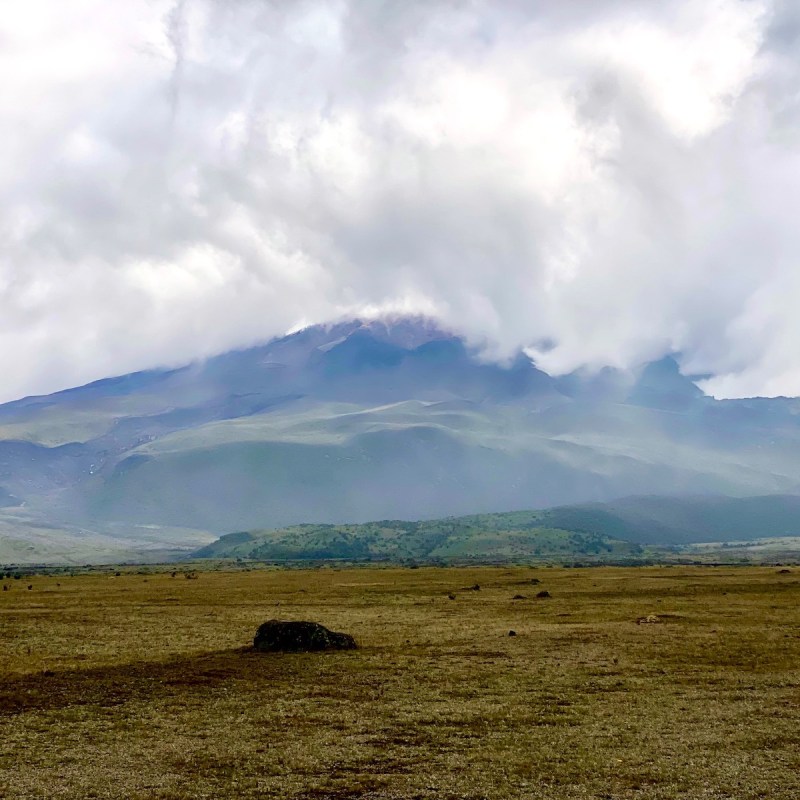
I couldn’t see that perfect, snow-capped conical volcano peak that Cotopaxi Volcano in Ecuador is so famous for, but as I strolled the dirt trail around a high-alpine pond, I wasn’t too upset about it.
Videos by TravelAwaits
For one, I was trying to catch my breath. At roughly 19,000 feet, Cotopaxi National Park outside of Quito, Ecuador is one of the highest spots in this South American country. Located in central Ecuador’s Andes Mountains, this national park sprawls over an area of 128.9 square miles, and Cotopaxi Volcano sits at a whopping 19,347 feet, making it the second-highest peak in the country.
If you aren’t used to the altitude, the thin air can take quite a while to acclimate to. Luckily, I brought my altitude sickness pills, so the altitude sickness wasn’t as rough as it usually is for me.
Coming from Oklahoma, which is relatively flat in areas, high altitude does a number on me, but thanks to the wonders of modern medicine, I was hiking with little to no problems in one of the most gorgeous spots in the Ecuadorian Andes.
I had already spotted a couple of the infamous wild horses that roam this national park, a few wild llamas, and countless birds, including the Andean Gull, a type of seagull that makes its home in the high peaks of the Andes mountain range.
In January, the weather was cool at this altitude, but not as cold as I expected. The famous conical peak of Cotopaxi, however, was obscured by the heavy low clouds that threatened rain.
Nevertheless, hiking among the scrubby high-alpine landscape and watching the variety of birds was a treat, and I only wished I had several days to backpack through this Ecuadorian treasure.
As a guest of Hurtigruten Expeditions’ inaugural cruise to the Galapagos Islands, I had the opportunity to enjoy one of the add-on options for the cruise itinerary — a day exploring Cotopaxi National Park.
After all, if you are in or near Quito, Cotopaxi is the one national park in Ecuador that should not be missed.

High And Mighty
Cotopaxi is a stratovolcano, and it’s still considered active with the last eruption occurring in 2016. It’s part of the Pacific Ring of Fire volcano chain, but Cotopaxi has the distinction of being one of only two volcanoes in the world with a nearly symmetrical cone shape that is always covered in snow. The other one is Mount Fuji in Japan, and both are some of the most picturesque peaks in existence.
Cotopaxi National Park also has one of the few glaciers that exists along the equator. The park was established in 1975 to help protect this high alpine landscape from encroachment, and it remains one of the most popular destinations in Ecuador for visitors and local residents alike.

Because of its altitude, Cotopaxi National Park boasts different vegetation zones ranging from humid mountain forest along the lower elevations to alpine areas with little vegetation to the wet sub-Andean plains.
Because of this variety of climates, visitors to Cotopaxi have the ability to see unique plants and animals that only exist in certain conditions. For instance, the park has 200 different plant species, but also an abundance of wildlife, including Andean wolves, deer, llamas, pumas, hundreds of bird species, and the tiny and tough marsupial mice.
The views in and around Cotopaxi National Park are worth a day or more exploration in and of itself.
Because it is located so close to the metropolitan cities of Quito and Latacunga, Cotopaxi National Park is one of the most visited parks in the country. Although Cotopaxi is one of the highest active volcanoes in the world, while in the park, you can also see two smaller volcanoes: Morurco and Rumiñahui.
Pro Tip: I am not a doctor by any means, but if you also suffer from altitude sickness, you might want to ask your physician to prescribe altitude sickness medications before you go. You can find all kinds of supplements online that claim to help you acclimate, but I was prescribed acetazolamide, a prescription medication used to decrease headache, tiredness, nausea, dizziness, and shortness of breath that can occur in high altitudes, and it’s worked well for me.

How To Enjoy Cotopaxi
Outdoor adventures and cultural learning opportunities abound in this national park. I’m a hiking fan, so the variety of trails that weave through this high-altitude wonderland was a treat.

I did a short, flat easy 2-mile hike with Metropolitan Touring’s guides around Limpiopungo Lagoon, a beautiful lake that mirrors the surrounding peaks and is alive with all sorts of waterfowl. If you’re lucky, you might spot the wild horses of Cotopaxi (which we did!), or you might opt to do a horse riding tour with local companies like Ecua Horse Rides.
If you are truly hardcore, you might want to tackle the Mountain Ascent, which includes an 80-minute hike up the base of the mountain to the ascent launch. At the ascent launch, you’ll find a resting place to prepare for the overnight ascent, which takes about 6 hours. Most folks start the climb at 12:30 a.m. so they can catch the sunrise at the summit at 7:30 a.m.
This climb isn’t one of those technical ones that requires ropes and superhuman strength, but it is still quite challenging. In fact, of all the adventurers who attempt the ascent, only about half succeed.
Another rather difficult trail is the Cerro Ruminahui Trail, a 7.1-mile uphill trek to the summit. This trail has stunning views, but you’ll have to face an elevation gain of 2,828 feet, so it’s definitely rated a difficult hike.

Biking is another popular option for exploring Cotopaxi National Park. Ecuadorians have embraced the cycling craze, and this park caters to those who wish to feel the wind on their faces as they take to the trails. Several companies offer mountain biking tours in Cotopaxi National Park. The popular routes begin at a trailhead near the José Ribas refuge or follow the main road to Laguna Limpiopungo.
Pro Tip: You’ll have to check in at the rangers’ station at the entrance of Cotopaxi National Park. At this time, proof of vaccination is required and you must wear a mask in all indoor and outdoor spaces.
The park entrance has one of the few restrooms (you’ll have to pay 25 cents for toilet paper) and a small restaurant. But, the best entrance attraction are the local craft vendors who are set up at the entrance, selling everything from alpaca shawls to handmade crafts. I was able to buy alpaca scarves for roughly $8 a piece, and they made for wonderful gifts to bring back home.

How To Get There, Where To Stay
Cotopaxi National Park is roughly 31 miles south of Quito. While many people choose to travel with a local tour company, which provides transportation to and from the park, you can also take a taxi from Quito. Believe it or not, a taxi won’t cost too much and is a lot easier than trying to navigate the roads in a rental or your own vehicle. Other options include a private transfer, taking a train (believe it or not, the park does have its own train stop), or taking a bus. One option is the Cotopaxi Wanderbus, which travels to the park from certain locations in Quito or from these hotels. What’s great about the Wanderbus is that it is a hop-on, hop-off style bus, so if you want to stay the night at the park, you can just hop back on the bus in the next day or so to return to Quito.
The three entrance points to the park include the northern entrance, the Areá Nacional de Recreación El Boliche, and the southern Control Caspi entrance, which is the most popular entrance into the park.
Ecuador uses the U.S. dollar, so paying for rides, activities, park fees, and food is super easy.
Cotopaxi National Park has several campgrounds, but camping there could be a bit tricky. Because Cotopaxi is an active volcano with eruptions causing issues in 2015 and 2016, camping is not allowed if the volcano starts to show signs of activity. If you do want to camp, the easiest way to find the designated campgrounds is to ask guides at the entrance to the park which areas are open.
Another option is to stay at one of the haciendas, lodges, or hotels just outside of Cotopaxi National Park.
Go There
Ecuador is one of my newest favorite places I’ve visited, and not just for Cotopaxi National Park. The country is easy to navigate, especially if you use a tour company like Metropolitan Touring, and the fact that the U.S. dollar is the national currency made it super convenient.
If you have the time or if you are on the Hurtigruten Expeditions Galapagos Cruise, I also recommend visiting Mashpi Lodge, a rainforest hotel owned by Metropolitan Touring in the Mashpi Reserve. This 2,500-acre private reserve is protected and located within the Chocó biogeographical region of Panama, Colombia, Ecuador, and Peru, and is home to a staggering 400 species of birds.
Ecuador is home to 11 national parks, each in different regions and climates of this small country, so don’t limit yourself. That being said, if you have limited time, then Cotopaxi National Park is the one national park in Ecuador that should not be missed.

